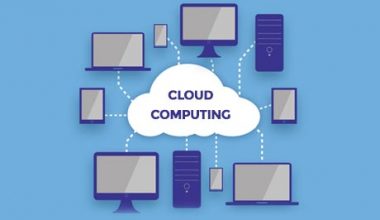The word ‘Clouds’ is used as a symbol to depict the Internet for more than two decades. As a virtual space that connects users from all over the globe, the Internet is like a cloud, sharing information by way of satellite networks. Cloud computing is a type of computing that depends upon shared computing resources.
In its most simple description, cloud computing is taking services (“cloud services“) and moving them outside an organization’s firewall. A cloud-based solution denotes on-demand services, computer networks, storage, applications, or resources accessed via the internet and through another provider’s shared cloud computing infrastructure.
An Epitome of Cloud Computing
Cloud computing is an umbrella term that refers to Internet-based development and services. Cloud computing became popular in the twenty-first century. The evolution of this concept is the result of the gradual development of the idea of computing since the 1950s. It is necessary to know the history of cloud computing more precisely before using it or if you are using it currently.
- 50’s & the 60s: Multiple users were capable of accessing a central computer through dumb terminals, whose only purpose was to deliver access to the processer or mainframe.
It was not easy for any organization to organize distinct computers for all of its employees because of their high purchase and maintenance costs.
Furthermore, the processing power and the storage capacity delivered by the processer were also not required instantly by most of its users.
This financial difficulty gave birth to the idea of consuming this technology economically by delivering shared access to a single source, the central computer. - In the 1970s: The concept of Virtual Machines (VM) evolved in the mind of researchers. The Virtual Machines operating system took the 1950s’ shared access mainframe to the next level, approving multiple distinctive computing environments to reside in one physical environment.
Virtualization motivated technology and was an important catalyst in the communication and information evolution. - In the 1990s: After the evolution of the visualization concept, several telecommunication companies provided private visualized network connections 1990s.
Earlier telecommunication companies offered only a single dedicated data connection to connect the user’s point-to-point. But the newly developed private connections offered visualized network which provided low-cost services in quality to the committed services.
These companies were now capable to run shared access to the same infrastructure to provide individual connections to more users without building new infrastructure. The term “cloud computing” was first used in an in-house document released by Compaq way back in 1996. - In 2000: Since 2000, cloud computing has come into existence. At the beginning of 2008, NASA’s Open Nebula boosted in the RESERVOIR European Commission-financed project, developed the first open-source software for arranging private and hybrids clouds, and for the federation of clouds.
In the same year, struggles were focused on delivering quality of service guarantees (as required by real-time interactive applications) to cloud-based infrastructure. - In 2006: Many believe the first use of “cloud computing” in its modern context occurred on August 9, 2006, the term was introduced by Google CEO Eric Schmidt at an industry conference.
Schmidt said, “What’s interesting is that there is an emergent new model. I don’t think people have really understood how big this opportunity really is. It starts with the premise that the data services and architecture should be on servers. We call it cloud computing—they should be in a “cloud” somewhere.”
The term began to use extensively in the following years after companies including Amazon, Microsoft, and IBM started to vend cloud-computing efforts as well.
The use of Cloud computing is spreading rapidly because it captures a historic shift in the IT industry as more computer memory, processing power, and apps are introduced in the “cloud” or remote data centers.
Some accounts trace the birth of the term to 2006 when large companies such as Google and Amazon began using “cloud computing” to describe the new model in which people are increasingly accessing software, computer power, and files over the Web instead of on their desktops.
Also Read:
Trends Transforming Cloud Computing in Year 2022
Cloud Delivery or Service Models
According to The National Institute of Standards and Technology (NIST), “cloud computing is a model for enabling ubiquitous, convenient, on-demand network access to a shared pool of configurable computing resources (e.g., networks, servers, storage, applications, and services) that can be rapidly provisioned and released with minimal management effort or service provider interaction.
A corporate trend among several businesses is the introduction of cloud-based systems. Here is an overview of the three more common types implemented in many businesses.
- Software as a Service (SaaS): Software as a service (SaaS) replaces the traditional on-device software with software that is licensed on a subscription basis. It is centrally accommodated in the cloud.
Without any downloads or installations, most SaaS applications can be accessed directly from a web browser. However, some SaaS applications require plugins. Using the cloud, software such as an internet browser or application can become a usable tool. - Platform as a Service (PaaS): Platform as a Service (PaaS) allows organizations to build or construct, run and manage applications without the IT infrastructure. This makes it simple and faster to develop, test, and organize applications.
Developers can emphasize writing code and producing applications without stressing about time-consuming. IT infrastructure activities such as provisioning servers, storage, and backup. It can diminish your management overhead and lower your costs. - Infrastructure as a Service (IaaS): It is like buying electricity. You need to pay only according to your use. This model enables companies to add, delete or reconfigure IT infrastructure on-demand. Most IT organizations trust IaaS because they are more acquainted with IaaS, specifically if they are experienced with virtual environments or strict security and regulatory requirements that can only be met through IaaS.
Types of Cloud Deployment
All clouds are not equivalent. Cloud computing can be divided into three different ways to deploy computing resources: public cloud, private cloud, and hybrid cloud.
- Public Cloud: Public clouds are possessed and function by a third-party cloud service provider, which brings their computing resources like servers and storage over the Internet. Microsoft Azure is a model of a public cloud. All hardware, software, and other supporting infrastructure are owned and managed by the cloud provider with a public cloud. You access these services and manage your account using a web browser.
- Private Cloud: A private cloud denotes to cloud computing resources used exclusively by a single business or organization. A private cloud can be tangibly situated in the company’s on-site data center. A private cloud is one in which the services and infrastructure are maintained on a private network.
- Hybrid Cloud: Hybrid cloud is a combination of different clouds, be it private, public, or a mix. The hybrid cloud gives businesses greater flexibility and more deployment options.
- Multi-Cloud: A multi-cloud strategy is the use of two or more cloud computing While a multi-cloud deployment can refer to any implementation of multiple software as a service (SaaS) or platform as a service (PaaS) cloud offerings, today, it refers to a mix of public infrastructure as a service (IaaS) environments, such as Amazon Web Services and Microsoft Azure.
Benefits of Cloud Computing
- Convenience
- Scalability
- Low costs
- Security
- Anytime, anywhere access
- High availability
- Worldwide Access
- More Storage
- Easy Set-Up
- Automatic Updates
In A Nutshell
Organizations are increasingly enjoying the benefits gained through cloud computing, whether through a single or multi-cloud approach. When defining or refining your cloud strategy, then, the real question you need to be examining is ‘do the benefits outweigh the risks, with a deep understanding of how the cloud will be used and managed in your organization, taking into consideration the factors discussed here.
Are looking for the best cloud computing solutions provider in India for your business?
We, Fusion Informatics in Bangalore, India are one of the pioneers in providing Cloud computing solutions and services, with adequate investment in skills and technological resources. Contact us today to explore how we can help you with finding the right cloud solutions and implementing them.
Our services also spanned over to other major cities of India such as Mumbai, Delhi, Bangalore, and Ahmedabad and other parts of the globe such as UAE and the USA. Contact us today and entitle the best deal!
Then this is the right time to contact us. You can reach out to us at [email protected] or you can call us at +91 63610 54076. We’re sure we can take it to the next level!



